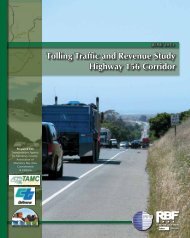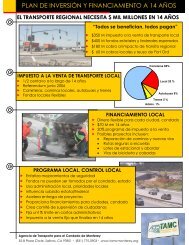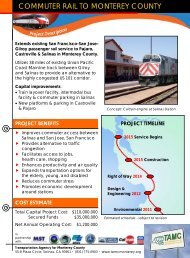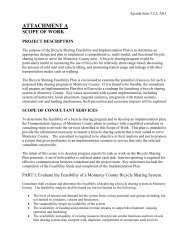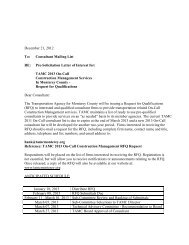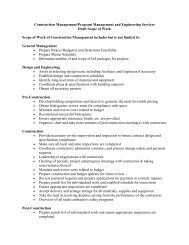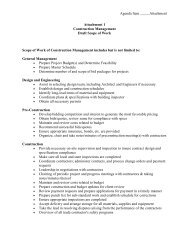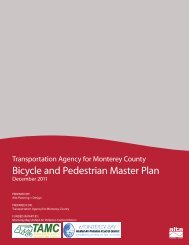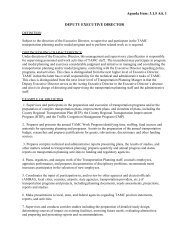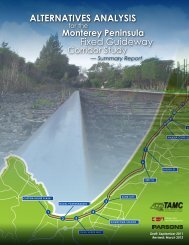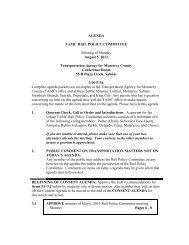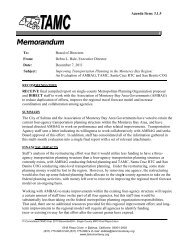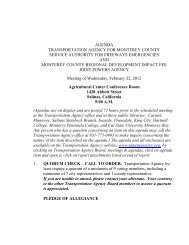Commuter Rail Extension Alternatives Analysis - Transportation ...
Commuter Rail Extension Alternatives Analysis - Transportation ...
Commuter Rail Extension Alternatives Analysis - Transportation ...
You also want an ePaper? Increase the reach of your titles
YUMPU automatically turns print PDFs into web optimized ePapers that Google loves.
CALTRAIN EXTENSION TO MONTEREY COUNTY PASSENGER RAIL STATIONSALTERNATIVES ANALYSISTable 6-14 lists the operating parameters associated with Year 2030 conditions, with the express busfleet transporting just under 2000 passengers in the peak commute direction during the AM and PMpeak periods. This scenario is equivalent to the four-train Caltrain <strong>Extension</strong> scenario.Table 6-14Express Bus Alternative Operating Parameters (2030 Conditions)Origin–DestinationRevenueRound Trip Revenue Miles Revenue HoursFrequency Daily MaximumMiles Hours (Minutes) Trips Vehicles Daily Annual Daily AnnualAveragePassengerLoad/Vehicle†Pajaro–Santa Clara Mid 107 3.08 30 8 4 856 218,280 24.67 6,291 41.75Pajaro–Santa Clara North* 128 3.97 30 16 8 2,048 522,240 63.47 16,185 45.25Pajaro–San Mateo/San Francisco 205 6.17 60 4 2 820 209,100 24.67 6,291 30.0Marina/Castroville–Santa Clara Mid 125 3.67 60 4 2 500 127,500 14.67 3,741 25.0Marina/Castroville–Santa Clara North 146 4.55 30 8 4 1,168 297,840 36.40 9,282 27.25Marina/Castroville–San Mateo/San Francisco 223 6.75 60 4 2 892 227,460 27.00 6,885 9.5Salinas–Santa Clara Mid** 132 4.00 30 16 8 2,112 538,560 64.00 16,320 42.5Salinas–Santa Clara North* 153 4.88 15 32 16 4,896 1,248,480 156.27 39,849 45.94Salinas–San Mateo/San Francisco 230 7.08 30 8 4 1,840 469,200 56.67 14,450 30.50Totals 50 14,722 3,858,660 467.82 119,294 39.26*Includes two stop groups—Mountain View and San Antonio; California and Palo Alto**Includes two stop groups—Diridon and Santa Clara; Lawrence and Sunnyvale†Peak directionTable 6-15 indicates the anticipated O&M expense associated with MST operating variousincrements of express buses to/from Santa Clara, San Mateo, and San Francisco counties eachweekday, excluding holidays. None of MST’s vehicle operators work straight, eight-hour shifts bydesign of its Union contract. Therefore, round trips to/from the San Francisco Bay Area would be splitinto two work pieces, with separate drivers working the morning and afternoon shifts.Average round trip travel time between Monterey County park-and-ride lots and San Francisco BayArea sets of Caltrain stations is computed to be 5.31 hours per shift, comprised of driverreport/inspection times, revenue service, driver recovery, and deadhead to/from the operationscenter. Some driver shifts would be less, some more, depending on the station sets served by theexpress bus routes. Run time estimates are based on anticipated 2030 conditions. Year 2010 runtimes, and therefore O&M costs, would be less.The O&M expenses identified in Table 6-15 assume that express bus vehicles have a seatedcapacity of 45 passengers per vehicle, and operate with an average load of 39 passengers pervehicle, equal to 87 percent of their seated capacity. 8 Lower or higher utilization rates and fewer ormore average pay hours per shift would affect these cost estimates. A minimum floor of eight vehiclesoperated in maximum service is reflected in the table, representing two trips per peak periodoperating from each park-and-ride facility in Monterey County. Increasing ridership levels could bematched closely by capacity increases given the relatively small size of the express bus units (45passengers per vehicle versus 550 to 700 passengers per four- or five-car train.8Average load = 1963 passengers/50 trips = 39.26 passengers/bus in peak direction.parsons CHAPTER 6: ESTIMATION OF CAPITAL, OPERATING AND MAINTENANCE COSTS, AND REVENUE 161



